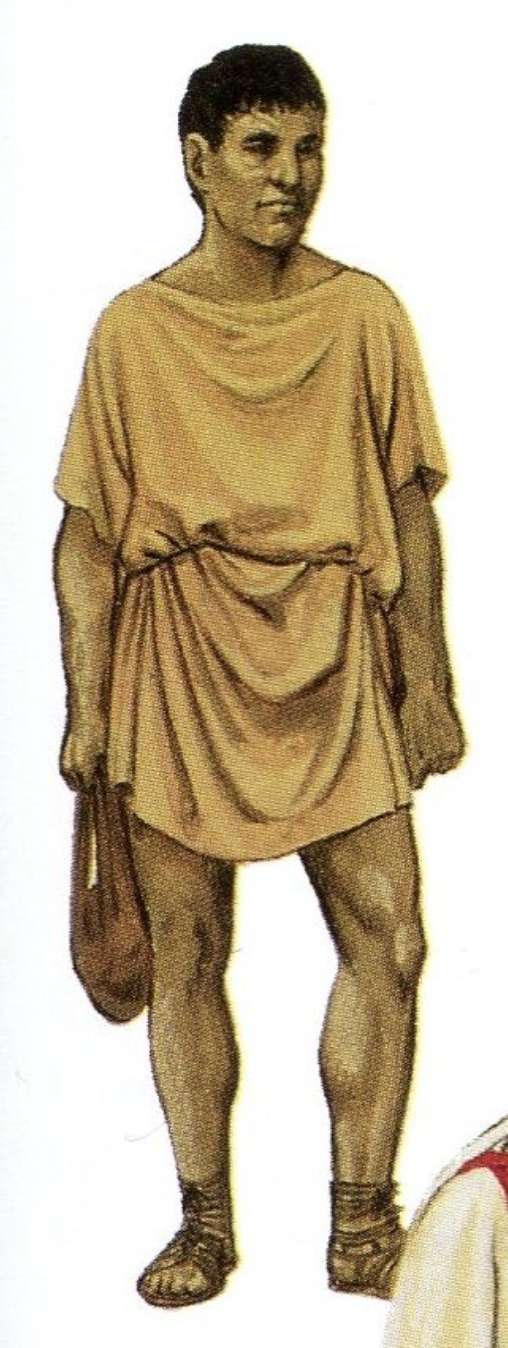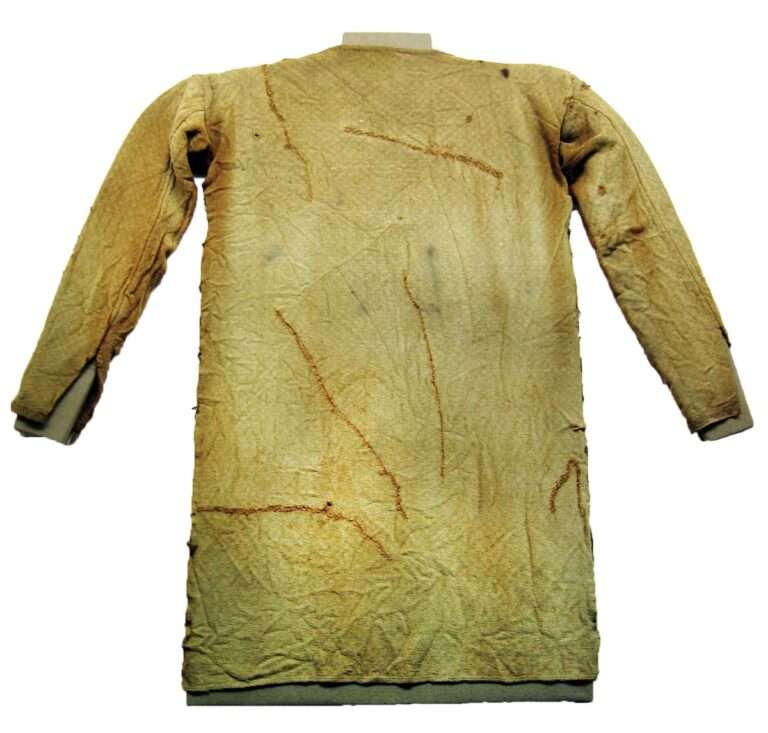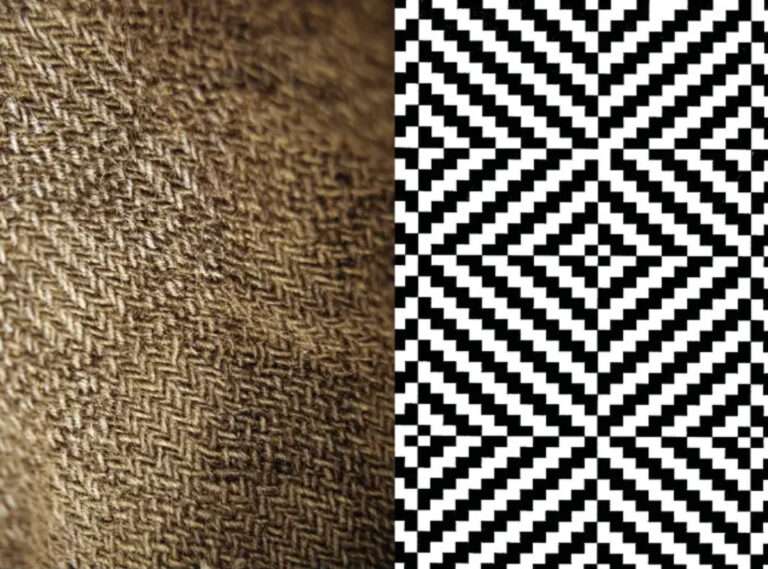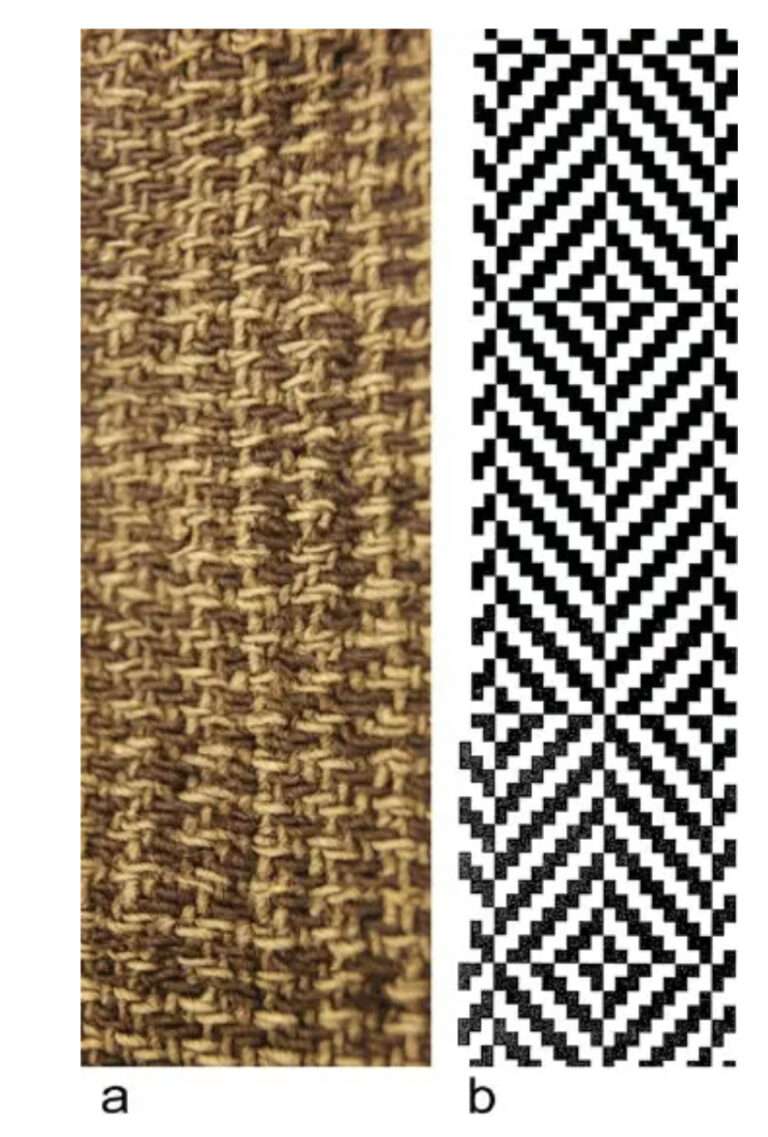
TUNIC
What did Vikings (Germanic people) wear?
The himation, the final category of ancient Greek women’s fashion, served as a basic outer garment worn by both genders over the chiton or peplos. It was a large rectangular piece of cloth that draped under the left arm and over the right shoulder. Archaeological evidence from statues and vases shows that these garments were often dyed in bright colors and adorned with various designs, woven into the fabric or painted on. One common way for women to wear the himation was to wrap it around their entire body and tuck a fold into their girdle. An example of this can be seen in the caryatid statues on the Erechtheion of the Acropolis in Athens, dating back to the late 5th century B.C.E. The sculptor skillfully carved the marble, depicting the himation surrounding the upper torso, passing through the left hand, and forming a fold attached to the right shoulder with clasps or buttons.Greek women donned himations in different styles, using them as warm cloaks over their lightweight Ionic chitons. On certain occasions, women would entirely cover themselves with their himations, veiling their faces when experiencing strong emotions or shame. The veil in ancient Greek women’s fashion also allowed them to express themselves and assert control over their movement and status in the male-dominated society. Unenslaved Greek women would wear a veil over their dress whenever they left the house. The influence of women’s fashion can also be seen in contemporary art, like the ‘Tanagra’ terracotta figurine, “La Dame en bleu,” which portrays a woman wearing a himation as a veil. The folds of the himation cover her head and shoulders, making her socially invisible and allowing her to enjoy privacy while in public. The custom of wearing a veil in public settings has connections to Eastern civilizations.







The long-sleeved tunics worn by various Germanic peoples in the colder regions of Middle and Northern Europe date back to ancient times, as depicted in historical images. These tunics were often shown on Roman monuments celebrating victories over these groups, displaying a simple pull-over design that reached either the mid-thighs or the knees. The Romans later adopted similar tunics, which remained in use during the Byzantine period. Even after the fall of the Western Roman Empire, the long-sleeved Celto-Germanic tunic continued to be popular. It underwent further developments from the earlier Graeco-Roman garment, featuring a tighter neckline with a front split for easy wearing, and gussets under the arms and around the lower half to create a flaring skirt. Vikings and Normans also embraced this garment, and it persisted as a common male attire throughout the Middle Ages. Remarkably, it was still in use in Norway as late as the 17th century.

中世を通じて、ビザンツ・ローマでは男女ともにチュニックが基本的な衣服であり続けました。上流階級では、基本的なチュニックの上に、ダルマティカ(dalmatica)と呼ばれる短くて重いタイプのチュニック(男女兼用)や、スカラマンギオン(scaramangion)と呼ばれるペルシャ発祥の乗馬用コートなどの衣服が加えられました。身分の高い者は、軍服や乗馬着を除き、くるぶしまで、あるいはそれに近い長さのチュニックを着ていた。これらのチュニックはしばしば染色されたり、複雑な刺繍が施されたりしたが、シンプルなものは重ね着に使われました。チュニックはビザンティン帝国の枠を超え、中世のヨーロッパ各地で袖や裾の長さを変えながら着用され続けていました。通常、チュニックは膝かくるぶしまであり、シャツ(多くの場合、腰丈かそれ以上)とドロワーズ(ブラッカに関連する膝丈かくるぶし丈のズボン)を含む下着の上に着用された。また、ホースを伴うこともあった。一般的な生地はウールやリネンだったが、裕福な人々は手の込んだシルクのチュニックを着たり、シルクの縁取りが施されたあまり豪華でない生地を着たりした。英語では、この衣服はサーク(sark)と呼ばれ、イギリス北部の方言ではシャツやシュミーズを意味する言葉として残っています。中世初期には、チュニックの首、裾、手首に装飾的な刺繍やタブレット織りの三つ編みが施されることが多かった。これはノルマン・コンクエスト以前のアングロ・サクソンでは、裕福な者も貧しい者も同様でした。



ドイツのスュデルブラロップ近郊に位置するトースベルグ湿原は、アングル人が奉納物を納める場所として約4世紀にわたって利用していた泥炭湿原です。この沼地から出土した遺物は、北ヨーロッパのローマ鉄器時代を理解する上で非常に重要な土地です。トースバーグ・ムーアから出土した最も重要な遺物には、初期のエルダー・フサルク語のルーン文字、ローマ時代のヘルメット、盾のバックル、初期の靴下(ズボンに取り付けられていた)などがあります。これらの出土品は、デンマークのイレルップやヴィモースで同時期に発見されたものと同様の重要性を持っています。トースバーグ湿原は、ローマ鉄器時代のアングル人の生活を垣間見ることができる貴重な遺跡である。沼地からの出土品は、彼らの文化、宗教、軍事習慣を理解するのに役に立っています。
例えば、トースベリ・シェイプは、剣の鞘を飾るために使われた銀金製の台紙です。剣の持ち主の名前と思われるエルダー・フザークのルーン文字で「ハリガスト」と刻まれている。この遺跡で発見されたローマ時代の兜も、北ヨーロッパで発見された数少ないローマ時代の兜のひとつであり、注目すべき発見です。
これらの重要な発見のほかにも、トースベルグ湿原からは武器、宝石、日用品など、さまざまな遺物が発見されている。これらの発見は、ローマ鉄器時代にこの地域に住んでいた人々の生活を垣間見る興味深いものであり、ヨーロッパ史におけるこの重要な時代についての理解を深めるのに役立っています。
ローマ時代に起源を持つゲルマン人のフィビュラや盾のボスのいくつかは、アングル人よりもローマ人と密接な関係にあった大ゲルマニアのゲルマン部族に関連しているかもしれません。紀元200年頃以降、武器の寄託が増加し、それはおそらくマルコマン戦争やローマ軍の遠征のような紛争によるものであろうと考えられています。寄託された遺物、特に武器の多くは、ケルト人の儀式によく見られる「殺す・壊す」という習慣に従って、意図的に破損されたり、折られたり、曲げられたりしていた。武器やその他の人工物とは別に、泥沼の堆積物には孤立した骨も含まれています。湿原に隣接して、ストーン・サークルを特徴とする鉄器時代の古墳も存在しています。











Here are some additional details about the German tunic:
▪️It was typically knee-length or longer.
▪️It could be either sleeveless or have short sleeves.
▪️It was often belted at the waist.
▪️It could be made of wool, linen, or other fabrics.
▪️It was often decorated with embroidery or other forms of ornamentation.
ゲルマン民族のチュニックは、さまざまな用途に着用できる万能の衣服でした。普段着としても正装としても軍服としても着ることができました。チュニックはゲルマン女性の間でも人気があり、スカートやズボンと合わせて着ることが多かっ多かったとされています。ゲルマン民族のチュニックはローマ帝国滅亡後も何世紀にもわたって着用され続けた。以下はゲルマン民族のチュニックについての詳細です:
▪️膝丈かそれ以上の長さが一般的だった。
▪️ノースリーブか半袖。
▪️ウエストをベルトで締めることが多かった。
▪️ウール、リネン、(シルク)生地で作られる。
▪️刺繍などの装飾が施されることが多かった。


When unfolded and studied, it proved to be a very well-preserved tunic, its fabric partly bleached where exposed to the sun and wind . Radiocarbon dating shows thatthe tunic was made between AD 230 and 390 (Tamers & Hood 2011; Figure 4). Only a handful of well-preserved tunics from this period have been found in Europe, and thereforethe new find is of great significance for dress and textile production and how these reflectthe interplay between northern Europe and the Roman world.
Nootherartefactswerefoundintheimmediatesurroundings,andthetextileisconsideredan isolated find with no demonstrable relationship to other objects found on the site sofar. The area of the find has been used for hunting over a long period up to moderntimes. Weapons, hunting and camping equipment and horse dung, as well as a variety of personal gear including textile remains, are among the finds that now emerge from the ice. At Lendbreen, a large variety and number of artefacts from different periods have beenrecovered, most of them connected to ancient hunting strategies, such as so-called ‘scaring sticks’.


チュニックは比較的短く、シンプルなカットで構成されていました。胸囲は約1.08m。現代のサイズ基準からすると、このチュニックは身長1.7~1.76mの細身の男性にぴったりでした。部分的に特に袖口周辺や腰の部分、背中などに激しい摩耗や破れが見られる。両袖だけでなく、下端や首の開口部の一部も断片化していました。本体部分は一枚仕立て。袖はカーブした袖口に縫製されています。胴体部分は下端に向かってやや幅広になっていました。この効果は袖口の上で生地を裁断し両脇に裾を作ることで製作されています。身頃部分は着用者の右側で折り返され、左側に縫い目がありました。首の開きはいわゆるボートネックで、前後に単純なひだのある平らなストレートネックです。縫い目が前方に位置するため首の開きの後ろの縁はわずかに盛り上がり、縫い目より約40mm高くなっています(B)。袖口は湾曲しており、脇の下から肩口までの幅は0.21mと比較的狭い。開口部は10mm幅のダブルの裾で折り返されています(C)。袖は質の異なる糸で本体に縫い付けられています(D)。チュニックの下部は、少なくとも2回は修理された、使い込まれた衣服という印象を与えます。裾Eは数カ所で分断されているが、これらの部分の縁自体の傷みは中程度あります。チュニックの前身頃の縁は不揃いでちぎれている。両袖は肩から0.2~0.26mほど離れたところで一部ちぎれていました。両袖の残りの部分は幅の狭い筒状で、肩の後ろ部分から約50mmのところで縫い目があり、下端はやや前方に傾斜しています(G)。左袖の下部にほぼ長方形の断片がある。チュニックは2枚のパッチで補修されていました。正方形のパッチ(1)はチュニックの身頃部分と同じ生地で作られています。パッチは裏側から縫い付けられています(H)。最初の縫い目から約50mm外側に同様の縫い目があり、パッチを固定してあります。これを補強するために、もう一つ大きなパッチ(2)が裏側から最初のパッチの上に付けられた。約0.24×0.41mを覆っていますが、右からは見えません。







